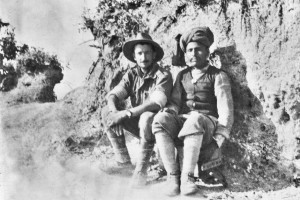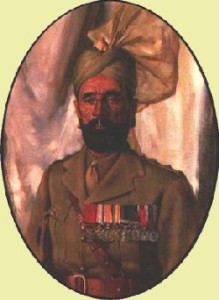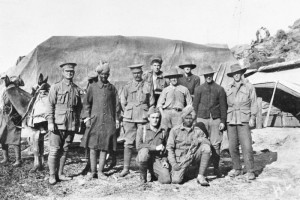Three Gurkha Divisions and one Sikh division also fought in Gallipoli alongside Australians
Two soldiers, one of them an Indian wearing a turban, on the Gallipoli Peninsula in 1915 (Pic. Australian War Memorial)
As we approach Anzac Day and commemorate Australians fighting in Gallipoli where they lost 9,000 soldiers, up to 15,000 Indians also fought with the allied troops at Gallipoli, but their contribution remains relatively unknown and unrecognised in Australia and their homeland, research has found.
An Indian soldier gives another soldier a haircut in Gallipoli, November 1915
The Indian army during World War I contributed a large number of divisions and independent brigades to the European, Mediterranean and the Middle East theatres of war in World War I . Over one million Indian troops served overseas, of whom 62,000 died and another 67,000 were wounded. In total at least 74,187 Indian soldiers died during the war.
Khudadad Khan, first Indian to be awarded a Victoria Cross
In World War I the Indian Army fought against the German empire in German East Africa and on the western front. At the first battle of Ypres, Khudadad Khan became the first Indian to be awarded a Victoria Cross. Indian divisions were also sent to Egypt, Gallipoli and nearly 700,000 served in Mesopotamia against the Ottomman empire.
A sergeant major of the Indian Mule Corps at Gaba Tepe, Gallipoli, in 1915.
In April 1915, Indian Expeditionary Force G was sent to reinforce the Gallipoli Campaign. It consisted of the 29th Brigade, serving away from its parent 10th Indian division. Consisting of three battalions of Ghurkhas and one of Sikhs, the brigade was dispatched from Egypt and attached to the British 29th Division which had been decimated in the earlier battles. Held in reserve for the second battle of Krithia they played a major part in the third battle of Krithia. Advancing on the left the Brigade was quickly halted except along the Aegean shore where the 1/6th Gurkha rifles managed to advance. The 14th Ferozepur Sikhs, advancing along the floor of Gully Ravine, were almost wiped out, losing 380 men out of 514 and 80% of their officers. The Brigade was next involved in the Battle of Gully Ravine and here the 2/10th Gurkha Rifles managed to advance half a mile. The Brigade next took part in the Battle of Sari Bair, under cover of a naval bombardment the 1/6th Gurkha Rifles assaulted and captured the hill, which was then shelled by the Royal Navy. With their casualties mounting and under command of the battalion medical officer they were forced to withdraw to their starting positions. With the failure of the assault at Sari Bair the brigade was withdrawn to Egypt. Over the duration of the campaign the 29th Brigade had suffered 1,358 dead and 3,421 wounded.
Indian gunners
In Sydney’s Parramatta Townhall’s Jubilee room a detailed photographic exhibition of Sikhs military history is on currently till the 25th of April 2015 which was opened by the Mayor of Parramatta.
During the recruitment by the British Army to fight and participate in World War 1, one and a half million volunteers came forward from the estimated population of 315 million in the Indian subcontinent (present- day India, Pakistan, Bangladesh and Sri Lanka – henceforth referred to, for convenience, as ”˜India’).
Of these 140,000 saw active service on the Western Front in France and Belgium – 90,000 in the front-line Indian Corps, and some 50,000 in auxiliary battalions. Nearly 700,000 served in the Middle East, fighting with great distinction against the Turks in the Mesopotamian campaign. Indians served on the Gallipoli peninsula, and others went to East and West Africa, and even to China.
Indians were mainly used to herd mules to deliver supplies and many became good friends of Australians. Along with Australian, New Zealand and British units, the 29th Indian Brigade ”” the 14th Sikhs, and 5th, 6th and 18th Gurkha Rifles ”” made their way from North Beach, Anzac, into the Sari Bair range and up towards Chunuk Bair and other peaks.
Short URL: https://indiandownunder.com.au/?p=4860






